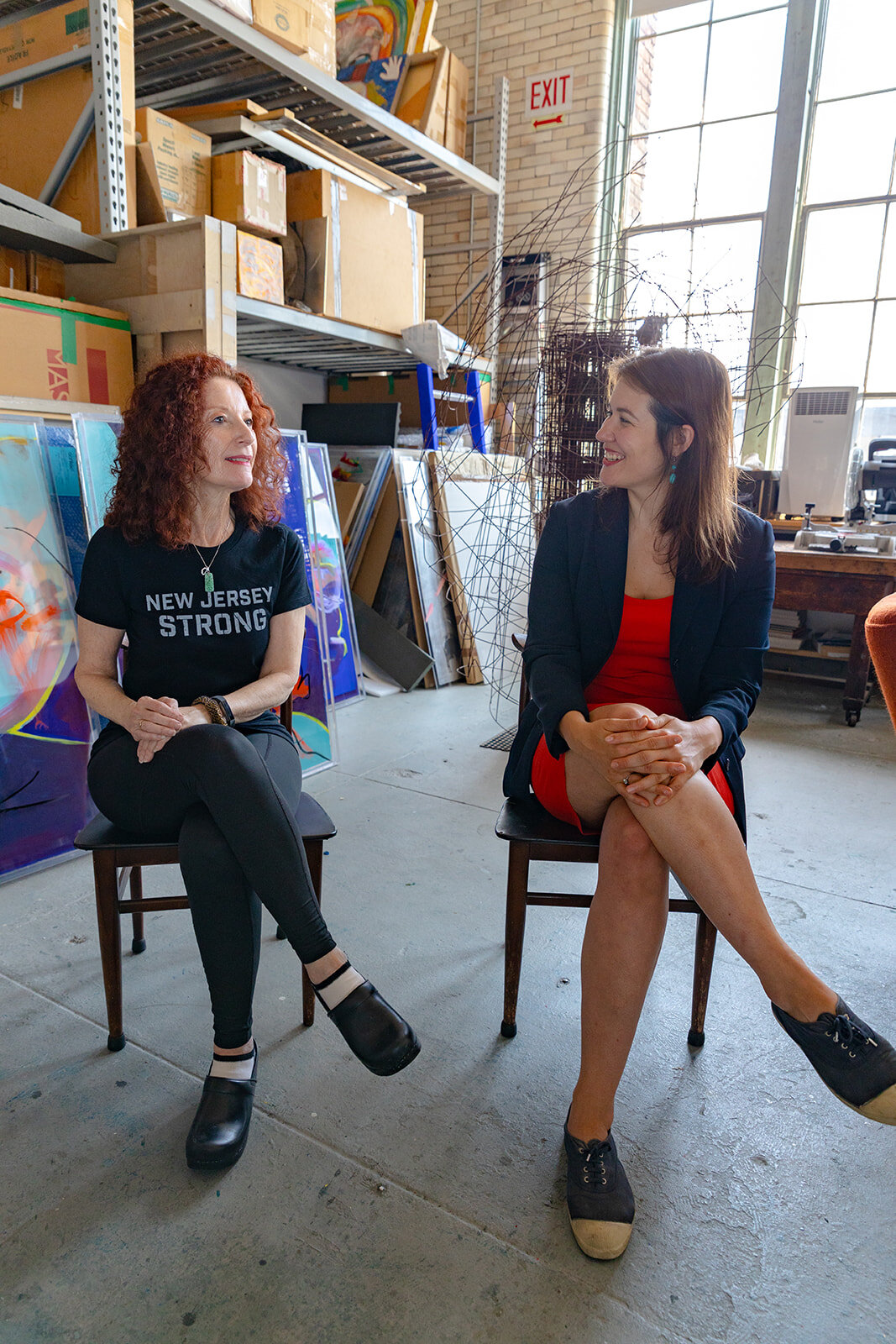Interview with the Shadow Painter Danielle Frankenthal
Danielle Frankenthal grew up in the U.S. and Guatemala. In 1984 she presented her first solo exhibition at the Galeria del Patronato de Bellas Artes. Light is the central focus of her work. She paints on transparent Acrylite® layers to build strong 3D structures, creating shadows that move as the day progresses. Her interactive works change with ambiance and the viewers’ position. She exhibited in museums around the world, including the Museum of Fine Arts in Houston, the Columbus Museum of Art in Georgia, and the Museo Casa Santo Domingo in Guatemala. Frankenthal received us in her studio at Mana Contemporary in Jersey City.
Danielle is a polyvalent artist. Her work is a result of gathering and experimentation. She calls on her curiosities about nature and chemistry and her philosophy education, to mix stories and materials that build powerful and colorful art pieces.
One example is her phosphorescent painting made from the same chemical composite as backup lights hospitals use during a blackout. It’s plastic infused with pigment at production over which she paints. She warns us “It’s not blue, you’re going to see.” She brings us to a black out room, and it appears: the piece is shining. Now we see first hand how work changes throughout the day. The transparent layers give space for shadows to move with the day's natural light phases, while the colors and pigmentation evolve with the dark night revealing a shimmering glow. Frankenthal applies paint to both sides of each acrylic resin pieces and assembles them, letting light penetrate the panels, but not the colors. Talking about her “Moon Sequence'' series, she says, “the moon comes up every night, and it’s always different. I wanted that to appear in my work.” A series of paintings, full of poetry, which reflects temporality.
We question her about her work process and inspiration, and she answers.
DF: “Originally, I was a mark-making artist. So on each of my pieces, you see marks. I like calligraphic pieces, and I think my work comes out from my studies of Japanese arts. The way Japanese printmakers use space and lines is incredible. Their lines are so alive. Lines are the expression of most of the energy in a piece of art. You can add colors, but the line has the energy. I use transparent Acrylite® layers, which I superpose. I can’t get more than three layers as it would be too heavy for the structure, and the light wouldn’t go through the pieces. Those layers became my ‘trademark’.”
Frankenthal fell into the arts as a child and credits the influence of her parents. She shares that her dad fell in love with pre-columbian art, and her mom started a library in Guatemala. “She would bring books for the kids every time they were going to Guatemala.” Frankenthal went to art school every Saturday, and Guatemala impacted her work and her life mantra. Her work “Butterflies” was inspired by her parent’s house in Guatemala, with woods, a lake, and a road around the lake. “I’m not a wasteful person by nature. That comes from living in poor countries like Guatemala.”
As years passed by, her work came back to a narrative abstraction. She shows us her last piece of work, “Pandora’s Box,” inspired by Greek mythology, and says, “I like making up stories.” She shows another painting created about the Greek goddess Persephone, who she says “is starting to rise out of the darkness.”
As for her influence, she says: “The reason I came to understand what I was actually doing is that I used to have a colleague, the Japanese artist Kumi Yamashita, who gave me a Japanese philosophy book and said I should read the parts about shadow.” Yamashita moved upstate but was her closest friend at the art center. The famous shadow sculptor reinforced Frankenthal position towards the importance of light in her work.
Frankenthal created chairs for the exhibition “Outside the Lines: Unlikely Iterations of the Abstract” at the Contemporary Art Museum of Houston, where people could take each other’s portraits through her work. There was a QR code on the wall for visitors to scan. They could take pictures of people sitting on the chairs, and the images would appear on the wall. She collaborated with an engineer for that project. The original design had no border, but she wanted to make sure it would support a three-year-old jumping on it or a three hundred pound man sitting.
As she reflects on her journey in the art world, Frankenthal says it’s difficult to continually perform. “An artist needs to be strong and to fight. Sometimes you’re at your top and sometimes you have to do small jobs for living. I told myself in bad times, ‘hang in there, you have to hang in there.”
When she was 20, Frankenthal met the Chief Curator of Contemporary Art of the Met Museum. “He asked me [Frankenthal] what I wanted to do. I said that I wanted to be a painter. He said ‘go home and paint…’ Also, I worked for my sister’s printing company. I met artist-colorist Joseph Marioni. Joseph taught me how to move things. He would take me to an opening and say ‘You don’t walk in look at the art and leave. You stay, talk to people, you try to be noticed.’ He had his first big solo show in New Mexico, in Santa Fe. He invited me to his open and introduced me to his gallerist. He got me to all my museums… At the time, when my career was at its top, I was represented by five galleries. They all closed. Then I had to start all over again. It’s important to be strong.”





